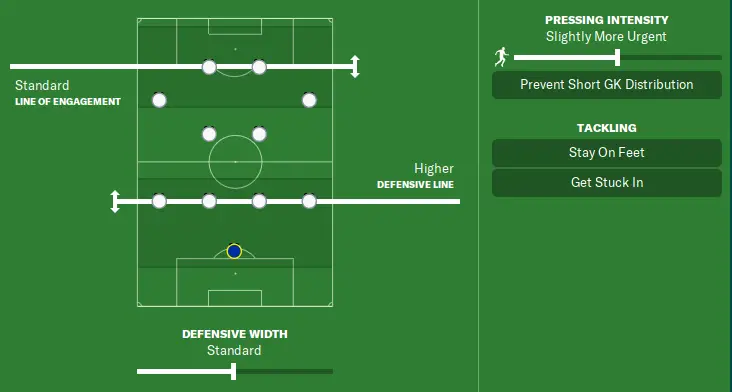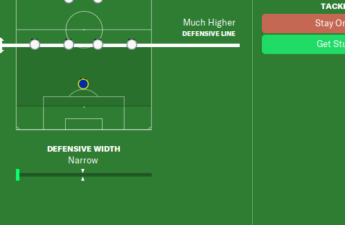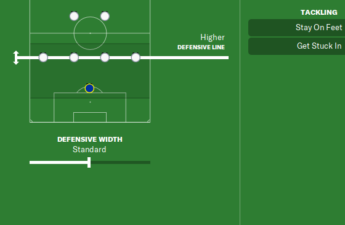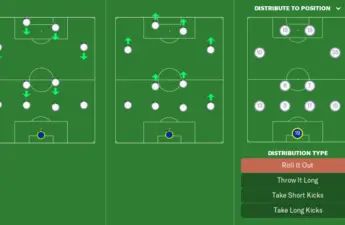The line of engagement in football manager is where the forwards in the team begin to press the opposition to try to win the ball back.
Depending on how you want to set up your team’s defensive shape, you need to shift the line of engagement upwards towards the opposition box or downwards to make your team more compact.
In this guide, I will cover the different lines of engagement in football manager, and how to use them in different game scenarios or to implement a certain style of play that you have in mind.
Much higher line of engagement in FM
The Much higher line of engagement is the highest setting possible and football manager describes it as a team instruction that instructs players to actively press the opponent in possession much further up the pitch.
I would only use this line of engagement if I am extremely desperate in searching for a goal with time running out.

The only other situation where this can be useful is if you have very fast central defenders at the back that can deal with the opposition sending balls over the top while your team is pressing high.
You can opt to press very high but still have a defensive line that is not very high, but this will then have the consequence of spreading your midfield too far, making it easy for the opposition to pass the ball around in the central areas of the pitch.
You can hop over to the guide on defensive lines for more on how to set them up. But generally, a higher line of engagement should also translate to a higher defensive line.
A much higher line of engagement aims to put the opposition under pressure immediately after their goalkeeper starts playing out from the back.
Liverpool under Jürgen Klopp is very effective at doing this, and if you have the right players who can relentlessly press, you stand to benefit from the opposition giving up cheap goals or hoofing the ball up the pitch where your defensive midfielders and centre-backs stand a chance of gaining possession of the ball.
Higher line of engagement in FM
The Higher line of engagement is defined as a team instruction that asks your players to actively press the opponent in possession further up the pitch.
It is the second-highest setting, and in my opinion, strikes the perfect balance of asking your team to press high without the need of feeling pressure to significantly raise your defensive line.
For this to effectively work, you obviously need the players who can press well, as well as positioning them in the right places from where they can effectively hound the opposition.
Formations that have four or five players near the attacking third are perfect for pressing high up the pitch.
4-2-3-1 or 4-2-4 for instance have four players that start high up the pitch, making them perfect for a relentless pressing style.
This is as opposed to say a conservative 4-1-4-1, 4-4-2 or 5-3-2 formations that do not have as many players in the final third when the opposition has the ball.
For such tactics to work, you would then need good players at the back that can hold their ground without the need of defending in numbers.
This makes a higher line of engagement suit dominant sides that possess the best players. Trying to press high with a weak side, exposing your backline to more 1 v 1 opportunities against good players can make your team concede more goals than necessary.
Standard line of engagement in FM
If you are unsure of what line of engagement to set for your team, starting at standard and shifting downwards if you are too open at the back or upwards if your defence is solid and want to put more pressure on the opposition is a good place to start.
The standard line of engagement takes your team mentality into account and can be higher if you are on the more attacking mentalities and lower on the more defensive ones.
Lower line of engagement in FM
A lower line of engagement asks your players to wait until the opposition comes toward them before engaging them in a pressing game.
You would ideally let the opposition come forward before engaging them in a press, for a few reasons.
The first reason is if you do not have players with the physicality to press high up the pitch. Letting the opposition first come towards you makes it less likely that your players will easily get fatigued from harrying the opposition very high up the pitch
The second reason for using a lower line of engagement is to create spaces behind the opposition’s defensive line for counter-attacking opportunities.
If you have fast strikers that can chase through balls from deep, sitting back and letting the opposition come to you can be an effective way of getting in behind their defence once you win the ball back.
A lower line of engagement is also useful in the dying minutes of the game, when you want your team to be as compact as possible and not give the opposition any space that they can use to expose your defence.
Dropping back and letting the opposition struggle to find a way through your defence is an effective way of defending, as long as you maintain some threat on the counter-attack
Much lower line of engagement in FM
Much lower line of engagement in football manager instructs players to wait until the opposition comes much closer to them before engaging them,
Just like the much higher line of engagement, I would only use this team instruction in very desperate situations.
In this case, I would only use this if am a huge underdog protecting a lead in the dying minutes of the game against a very attacking side like PSG or similar.
I feel like football manager rarely works well with ultra-defensive setups and this can easily lead to your team being pushed too back towards your own half that you can not easily get out.
With a much lower line of engagement, you would also be forced to drop back your defensive line, otherwise, your midfield area would become too compact.
There are sides in real life that work well sitting very deep, then typically relying on big centre forwards that can hold up play to get the team further up the pitch when they win back possession.
Burnley under Sean Dyche for instance, was the perfect example of this, sitting back and then hoofing the ball to one of Chris Wood or Jay Rodriguez, who would then hold the ball up to get the team further up on the pitch.
If you have found this useful, head over to the defensive lines guide, as it is heavily tied to lines of engagement.


